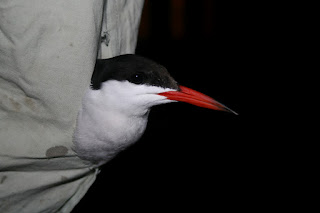I received an answer from the
Polish Ringing Center about their HN-45088 Common Tern, caught on 6th
May at Atlit salt pans. This bird was ringed as pullus in summer 2008 near
Warsaw by A. Olszewski. The distance between the ringing site in Poland and the
recapture site in Israel is 2464 km (see map). This is the first Polish control
of Common Tern in Israel, and only second spring control, the other was from
Ukraine (1984). I fitted this bird with a white plastic ring with black code I76
and I hope it will be resighted again in Poland or perhaps in winter in Africa.
Tuesday, 29 May 2012
Monday, 28 May 2012
Breeding season
Last Sunday I visited my CES; numbers of
juveniles are going up- many Reed Warblers, Sardinian Warblers, Graceful Prinias
and one juvenile Blackbird. I had still some late migrants, Great Reed Warbler,
Sedge Warbler, Marsh Warbler and Blackcaps.
 |
| Juvenile Reed Warbler |
In Atlit we caught 25 birds: 18 Common Terns,
6 Little Terns and one Little Stint. In this period tern migration is over and the
breeding population is too busy. I will return to ring them when the chicks fledge
in a few weeks.
 |
| Common Tern |
Monday, 7 May 2012
Terns on the move
Another successful night at Atlit saltpans
(6-7/5) produced 111 birds caught. Most interesting was Common Tern with the
ring: HN 45.088 ST.ORN.GDANSK POLAND. This is the fourth foreign control since
I started my tern project in 2010 and first in spring migration, joining Finnish,
Lithuanian and German Common Terns caught in this place. Totals were 105 Common
Terns, including retrap from last year, only 3 Little Terns, 1 Ruff and 1
Little Stint.
After I ended my ringing session in the
morning I received a call from Tuvia Khan who had just observed three of my
Little Terns at Ma'ayan Tzvi fishponds, 12.5 km south. One ringed in August
2010, one in June 2011 and to my surprise one from this night. Interesting info
kept coming in; was continue when I arrived back to my computer I saw another
report of two ringed Common Terns observed and photographed in Hula Nature Reserve
by Dror Galili. IIF was ringed in August 2010 and IT3 ringed in June 2011, both
from Atlit, 76 km south west. Very interesting data about their movement inside
Israel.
 |
| IIF |
 |
| IT3 |
This night I ended all possible combinations for white plastic rings and started work with green rings for Common Terns.
Another note from this night: we caught many
Common Terns with dark bill. I don't know what the explanation for this is; perhaps
only regular variation within our local
breeding population or geographical variation among migrant birds.
 |
| Little Tern |
Many thanks to my team: Rafi, Ron, Eilai,
Yishai and Shachar.
Short ringing session in Tzor'a on Friday
produces 120 birds; first fledglings of Clamorous-reed and Cetti's Warblers
were ringed. Also I ringed this juvenile Whitethroat with active partial moult
- first sign of the upcoming autumn?
 |
| Juvenile Whitethroat - active partial moult |
Thursday, 3 May 2012
First tern ringing - putative White-cheeked Tern
After eight months without terns I visited Atlit
Saltpans for ringing. The first night of this season (29-30 April) was a complete
success with 64 birds caught; 60 Common Terns including one retrap from last
year, 1 putative White-cheeked Tern, 1 Little Tern, 1 Slender-billed Gull and 1
Little Stint.
The putative White-cheeked Tern is 2nd
calendar bird with typical primary moult and winter / non-breeding-like
plumage. The main features pro White-cheeked Tern are a grey rump, uppertail
and tail rectrices without contrast to mantle colour; in Common Tern there is a
clear contrast between the grey mantle and white rump (see image).
.JPG) |
| Putative White-cheeked Tern |
Second feature
is larger tail / wing ratio (longer tail, shorter wing). Tail length was 169
mm, the longest tail I have measured (n=387). The wing/tail ratio is 1.60 - a
very low figure, lower than the normal range of 1.62-2.85, average 2.00
(n=386); in 2nd calendar birds (n=10) the range is slightly higher,
1.93-2.75, so this bird has a really exceptional wing / tail ratio.
Another aspect of wing/tail ratio is the distance
between wingtip and tail; in this bird the tail is long than the wing. In other
birds caught this night (all adults) the wing was longer.
Other measurements:
Wing=270 mm
Tail=169 mm
Fork=85 mm
Bill(s)=43.5 mm
Bill(f)=35.2 mm
Tarsus=22.5 mm
In the past, this subject was discussed after
I caught terns with rump as White-cheeked and dark underparts. But this possibility
was overruled after images of mating Common Tern X 'like White-cheeked' Tern in
my ringing region were posted. This bird look better for a genuine White-cheeked
Tern, especially the tail pattern. This species breeding in the Red-Sea and
Indian Ocean is little known, especially in respect to the amount of variation
of these features in young birds. I searched for information about
identification and found only a short article from 1982 (Dutch Birding). I will
be glad to receive some information or ideas, especially biometrics.
 |
| Regular Common Tern |
Thanks to Avishai, Rafi and Eilai for their
help this night.
Subscribe to:
Comments (Atom)






